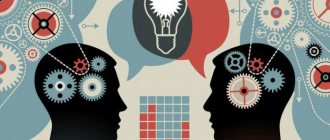- What is causal attribution
- What is the fundamental attribution error?
- Why We're Subject to a Fundamental Fallacy
The fundamental attribution error (sometimes the fundamental error of causal attribution ) is an interesting phenomenon in psychology, characteristic of the vast majority of people (of course, some to a greater extent, some to a lesser extent). Understanding what this mistake is will allow you to more adequately evaluate your own judgments about other people, better understand how they see our actions, and also analyze your successes and failures differently. However, before moving on to the error itself, let’s define what is meant in this case by causal attribution .
I. What is the fundamental attribution error
The fundamental attribution error is a cognitive error that causes people to underestimate the influence of situational environmental factors on people's behavior and overestimate the influence of personal dispositional factors.
Essentially, this means that the fundamental attribution error is what causes people to assume that other people's actions are less influenced by their environment than they actually are, and to assume that those actions are influenced by their personality more than they are. actually.
For example, a fundamental attribution error might lead someone to assume that if a stranger looks angry, then he must be a generally angry person, even though that person might have been driven to temporary anger by something, such as rudeness from others. someone else's.
The fundamental attribution error can have a significant impact on how people, including you, judge others, so it's important to understand it. So in this article, you'll learn more about the fundamental attribution error and see what you can do to properly account for it.
Why is subjectivity always present in perception?
There is an old Chinese parable about an elephant and the four wise men.
Errors of perception
The four wise men were blindfolded and led to the elephant. The first one was given the trunk of an elephant. The second has a tail. The third was brought to the side of the elephant. The fourth sage remained standing aside, and could only hear smells and sounds. Each of them was asked to describe the animal using the information they received.
The first one said it was a big, huge snake. The second is that this is a very big donkey. The description of the third was similar to that of a dragon. A fourth described the elephant as the noisiest and smelliest animal. In any case, having a limited amount of information, each of the sages completed the elephant based on their knowledge base and experience, using the information provided as a key.
Let's take a simpler example.
You pick up a seashell. Your friend gave it to you. Can you imagine how she swam in the sea. How your friend was at sea. You “complete” the information. Now, you are already convinced that your friend was on vacation at sea.
Attribution is the way that allowed you to complete this “completion”. And, it seems, everything is logical, but your friend was not at sea. He bought a shell from a souvenir shop on a nearby street. A friend knew that you missed the sea. The shell never swam in the sea. She grew up in a man-made pool on a sea farm.
II. Examples of fundamental attribution error
One notable example of the fundamental attribution error appears in the first study of the phenomenon, published in 1967 by Edward Jones and Victor Harris, two researchers at Duke University.
In the study's first and most famous experiment, participants were given what they thought was an essay written by a student for a political science exam on a controversial topic—Fidel Castro's Cuba. Some participants received pro-Castro essays and others received anti-Castro essays, and all were asked to rate the essay's author's true stance on the topic.
The experiment provided evidence of the fundamental attribution error, as participants who read the pro-Castro essay were significantly more likely to believe that the student who wrote it was himself pro-Castro, compared to those who read the anti-Castro essay, even when they were told that the student who wrote the essay had no choice in how he approached the topic. These results were replicated in a follow-up experiment in which participants read what they thought was a draft of the opening statement to a college debate on the topic.
Since then, other studies have found evidence of the fundamental attribution error in various fields. For example, additional examples of the fundamental attribution error include the following:
- People watching television shows often discover the fundamental attribution error when they attribute the behavior of the actors on the show to their personality rather than the script. Essentially, this means that people sometimes assume that an actor's behavior in their role reflects their true personality, rather than what the script dictates. Moreover, this effect has been found to remain constant even when a person exhibiting fundamental attribution error observes the same actor playing two different roles; in such cases, the last scene people watch usually determines their assessment of the actor.
- Students often exhibit a fundamental attribution error when they overestimate the internal reasons for teachers' expressions of anger. Essentially, this means that students assume that the main reason their teachers are angry is because they are angry people, not because their environment made them angry. This remains true even when students recognize that it is their own actions, such as misbehavior, deliberate provocation, or lack of effort, that earn the teacher's wrath in the first place.
Note: The term “fundamental attribution error” was coined by Stanford professor Lee Ross in 1977 in an article entitled “The Intuitive Psychologist and His Disadvantages: Distortions in the Attribution Process,” where Ross discusses the phenomenon based on earlier research. This term is often shortened to "FOA".
Causal attribution theories
There are several different theories explaining how causal attribution works. The most popular are two of them, each of which should be considered in detail.
The theory of correspondent relations
This theory was created by psychologists Edward Jones and Keith Davis. They hypothesized that people tend to consider any behavior of others to be intentional and attribute it to personality traits. This should help us better understand what we can expect from people in the future. If a person behaved in a friendly manner, we assume that he is friendly and will continue to behave in the same way.
Thus, according to this theory, causal attribution is the tendency to make natural conclusions that a person’s actions are fully consistent with his inner world. To denote the situation when an observer makes a conclusion about a person’s personality based on his behavior, the authors introduced the concept of “correspondent inference.” They argue that we draw this conclusion based on such sources of information as:
- Freedom of choice. If a person had the opportunity to choose and chose this particular action, then it is explained by his personal characteristics.
- Randomness or intentionality of behavior. If certain actions were committed by a person intentionally, we try to explain them by internal factors, but if something happened by accident, we look for external reasons.
- Social desirability. If someone engages in behavior that is characterized by low social desirability (i.e., “wrong”), they are attributed to personality traits.
- Personalism. If someone's actions influence us, we believe that they are due to the person's personal qualities.
- Hedonic relevance. Also, our conclusions about the personal qualities of another person are influenced by whether their actions brought us benefit or harm.
Kelly covariance model
The author of this attribution theory is the American social psychologist Harold Kelley, who published it in 1967. It is a logical model according to which people attribute certain behavior to internal motives or external factors.
In mathematical statistics, the term “covariance” refers to the mutual dependence of two random variables. Within the Kelly model, covariance refers to the dependence of attribution on random factors that are noticed and taken into account by the observer.
According to Kelly, when interpreting another person's behavior, people unconsciously use the same principles that scientists use in their research. In particular, he identified three criteria:
- Consensus (similarity). Does the person's behavior correspond to the typical behavior of most people?
- Distinctiveness. Are a person's actions towards an observer different from their actions towards other people?
- Consistency. In all situations does a person behave the same way towards the observer, or does his behavior depend on the situation?
As an example, consider the reaction of a person (let his name be Sergey) to a joke told in a company. If everyone, including Sergei, laughs, we can conclude that there is a high consensus. If only Sergei laughed, the consensus is low.
If Sergei laughs when this storyteller tells jokes, but perceives others no worse, the distinctiveness is high. If all the jokes seem funny to him, his distinctiveness is low. If Sergei always laughs when this person tells jokes, consistency is high; if not, consistency is low.
Now imagine a situation in which the jokes of a particular person cause the whole group to laugh, but at the same time they are not so willing to laugh in response to the jokes of another. In this case, we believe that Sergei is laughing, since the narrator who made him laugh is really talented at telling jokes. If only Sergei laughs, and at the same time he laughs at every joke, we can come to the conclusion that he is simply easy to make laugh.
In the example described above, we proceed from the fact that we have the opportunity to observe how Sergei behaves in different situations , how he reacts to different narrators, and how other participants behave. However, in reality, we often do not have such complete information, and we still find a convenient explanation for any situation, which we consider to be quite accurate.
In 1972, Kelly published a paper expanding on his theory. He supplemented it with principles that explain how we draw conclusions when there is a lack of information. In particular, this deficiency is compensated for by personal beliefs and accumulated life experience. In his published work, Kelly proposed 2 schemes:
- Many good reasons. There may be several factors, each of which is sufficient to have the necessary influence. An interesting side effect of this scheme is the devaluation of individual factors if we assume that there are several reasons for the current situation (if a person is late for work because there was no water in the tap and his bus was delayed, he does not attach importance to the fact that he overslept).
- Many necessary reasons. This scheme implies that we artificially combine several factors to explain a certain event, since only such a complex cause seems sufficient.
Kelly also described the “Principle of Magnification,” according to which the role of a cause is significantly exaggerated in the presence of negative factors. For example, if a person copes with a task despite unforeseen difficulties, he values his merits much higher.
III. Why People Make the Fundamental Attribution Error
The main reason people exhibit the fundamental attribution error is because it serves as a type of heuristic, which is a mental shortcut that people intuitively use to quickly make decisions and form judgments.
In particular, the fundamental causal attribution error can be considered a heuristic because it is easier and faster to assume that people's behavior is based only on their relatively stable internal traits than to consider the various situational factors that may influence it and try to separate people's actions from their intentions. . Accordingly, this bias is more likely to occur when people lack the cognitive resources or motivation needed to fully consider the influence of situational factors on people's behavior.
Moreover, in addition to speeding up the process of evaluating people and reducing the cognitive load during this process, there are other potential benefits of using this type of heuristic.
For example, a potential benefit of the fundamental attribution error is that the cost of incorrectly assuming that someone's actions are determined primarily by their predispositions rather than by situational factors is sometimes lower than assuming the opposite. Essentially, this means that when judging someone's actions, it is often preferable to assume that their behavior is influenced more by their personality than they actually are, rather than to assume the opposite.
Additionally, other reasons may also lead people to exhibit fundamental attribution error. For example, neuroscience research has shown that one possible reason why people exhibit this bias is that when they try to understand other people's intentions, they engage in mentalization, spontaneously processing the other person's mental state.
Finally, note that various factors have been found to influence the likelihood that people will exhibit the fundamental attribution error, as well as the degree to which they exhibit it. This includes both factors that have to do with the person making the judgment, such as their nationality or mood, and factors that have to do with the person being judged, such as thoughts about how their actions are perceived - positively or negatively. negative light. This is consistent with research on the general attribution process, which suggests that it may be biased for a variety of reasons and may also be influenced by various situational and personal factors.
To summarize, people exhibit the fundamental attribution error primarily because this form of thinking serves as a cognitive shortcut that allows them to make judgments faster and easier. Moreover, other factors may also cause people to exhibit fundamental attribution errors; this includes, for example, the fact that it is often preferable to overestimate rather than underestimate the influence of personality factors on people's behavior.
Recommendations
- Bicchieri, Cristina. "Scripts and schemes." Coursera - Social Norms, Social Change II
. Retrieved June 15, 2022. - Ross, L. (1977). "The Intuitive Psychologist and His Disadvantages: Distortions in the Attribution Process." In Berkowitz, L. (ed.). Advances in experimental social psychology
.
10
. New York: Academic Press. pp. 173–220. ISBN 978-0-12-015210-0. - ^ a b c
Jones, E. E.;
Harris, W. A. (1967). "Attribution of views." Journal of Experimental Social Psychology
.
3
(1): 1–24. Doi:10.1016/0022-1031(67)90034-0. - ^ a b
Gilbert, D. T. (1998).
"Speeding Up with Ned: A Personal Perspective on Bias in Correspondence" (PDF). In Darley, J. M.; Cooper, J. (Ed.). Attribution and Social Interaction: The Legacy of E. E. Jones
(PDF). Washington, DC: APA Press. Archived from the original (PDF) on 2011-07-09. - Gawronski, Bertram (2004). "Theoretical Correction for Bias in Dispositional Inference: The Fundamental Attribution Error is Dead, Long Live Correspondence Bias" (PDF). European Review of Social Psychology
.
15
(1): 183–217. Doi:10.1080/10463280440000026. Archived June 1, 2016.CS1 maint: BOT: Source URL status unknown (link) - "The fundamental error of attribution". Ethics without packaging
. McCombs School of Business, University of Texas at Austin. 2018. - ^ a b
Epstein, Seymour;
Teraspulsky, Laurie (1986). "Perception of Cross-Situational Consistency". Journal of Personality and Social Psychology
.
50
(6):1152–1160. Doi:10.1037/0022-3514.50.6.1152. - ^ a b c
Malle, Bertram F. (2006).
"Actor-observer asymmetry in attribution: a (surprising) meta-analysis." Psychological Bulletin
.
132
(6):895–919. Doi:10.1037/0033-2909.132.6.895. PMID 17073526. S2CID 12065432. - Lerner, M. J.; Miller, D. T. (1977). "Just Peace Research and the Attribution Process: Looking Back and Forward." Psychological Bulletin
.
85
(5):1030–1051. Doi:10.1037/0033-2909.85.5.1030. - Burger, J. M. (1981). "Motivational biases in attributions of accident responsibility: A meta-analysis of the defensive attribution hypothesis." Psychological Bulletin
.
90
(3):496–512. Doi:10.1037/0033-2909.90.3.496. S2CID 51912839. - Walster, E (1966). "Attaching responsibility for an accident." Journal of Personality and Social Psychology
.
3
(1):73–79. doi:10.1037/h 0022733. PMID 5902079. S2CID 26708943. - Gilbert, D. T.; Malone, P. S. (1995). “Correspondence bias” (PDF). Psychological Bulletin
.
117
(1):21–38. Doi:10.1037/0033-2909.117.1.21. PMID 7870861. Archived from the original (PDF) on 2005-12-11. - Abrams, D.; Vicki, G. T.; Masser, B.; Boner, G. (2003). "Perceptions of Stranger and Acquaintance Rape: The Role of Benevolent and Hostile Sexism in Victim Blaming and Rape Proneness." Journal of Personality and Social Psychology
.
84
(1):111–125. Doi:10.1037/0022-3514.84.1.111. PMID 12518974. S2CID 45655502. - Bell, S.T.; Kurilov, P. J.; Lottes, I. (1994). "Understanding Blame Attributions in Stranger Rape and Date Rape Situations: Exploring Students' Gender, Race, Identity, and Social Perceptions of Rape Victims." Journal of Applied Social Psychology
.
24
(19): 1719–1734. Doi:10.1111/j.1559-1816.1994.tb01571.x. S2CID 144894634. - Summers, G.; Feldman, N. S. (1984). “Victim Blaming versus Perpetrator Blaming: An Attributional Analysis of Spousal Abuse.” Journal of Social and Clinical Psychology
.
2
(4): 339–347. doi:10.1521/jscp.1984.2.4.339. - Wugler, R. J. (1988). Other Lives, Other Selves: A Jungian Psychotherapist Discovers Past Lives
. New York, Bantam. - Lassiter, F.D.; Geers, A. L.; Munhall, P.J.; Ploutz-Snyder, R.J.; Breitenbecher, D. L. (2002). "Illusory Causality: Why It Happens." Psychological Science
.
13
(4): 299–305. Doi:10.1111/j.0956-7976.2002..x. PMID 12137131. S2CID 1807297. - Robinson, J.; MacArthur, L. Z. (1982). "The influence of salient vocal qualities on causal attributions of speaker behavior." Journal of Personality and Social Psychology
.
43
(2):236–247. Doi:10.1037/0022-3514.43.2.236. - Smith, E. R.; Miller, F. D. (1979). "Salience and cognitive appraisal in emotion." Journal of Personality and Social Psychology
.
48
(4):813–838. Doi:10.1037/0022-3514.48.4.813. PMID 3886875. - Storms, M. D. (1973). "Video recording and the attribution process: Contrasting perspectives of actors and observers." Journal of Personality and Social Psychology
.
27
(2): 165–175. doi:10.1037/h0034782. PMID 4723963. S2CID 17120868. - Gilbert, D. T. (2002). Output correction. In T. Gilovich, D. W. Griffin, & D. Kahneman (Eds.) Heuristics and biases: The psychology of intuitive judgment
. Cambridge University Press. - Carlston, D. E.; Skowronski, J. J. (1994). "Economies of Relearning Feature Information as Evidence for Spontaneous Inference Generation." Journal of Personality and Social Psychology
.
66
(5):840–880. Doi:10.1037/0022-3514.66.5.840. - Moskowitz, G. B. (1993). "Individual differences in social categorization: The influence of personal need for structure on spontaneous trait inferences." Journal of Personality and Social Psychology
.
65
: 132–142. Doi:10.1037/0022-3514.65.1.132. - Newman, L. S. (1993). "How People Interpret Behavior: Idiocentrism and Spontaneous Trait Inference." Social cognition
.
11
(2): 243–269. Doi:10.1521/soco.1993.11.2.243. - Uleman, J. S. (1987). "Consciousness and control: the case of spontaneous property inferences". Personality and Social Psychology Bulletin
.
13
(3): 337–354. Doi:10.1177/0146167287133004. - Winter, L.; Uleman, J. S. (1984). “When are social judgments made? Evidence for the spontaneity of inferences." Journal of Personality and Social Psychology
.
47
(2):237–252. Doi:10.1037/0022-3514.47.2.237. PMID 6481615. S2CID 9307725. - ^ a b
Gilbert, D. T. (1989).
Thinking about others easily: Automatic components of the social inference process. In J. S. Uleman & J. A. Bargh (Eds.), Unintentional thought
(pp. 189–211). New York, Guilford Press. - Lugdridge, Darren; Trevor Butt (September 2004). "The Fundamental Attribution Error: A Phenomenological Critique." British Journal of Social Psychology
.
43
(3):357–369. Doi:10.1348/0144666042037962. PMID 15479535. - Miller, J. G. (1984). "Culture and the Development of Everyday Social Explanation" (PDF). Journal of Personality and Social Psychology
.
46
(5):961–978. Doi:10.1037/0022-3514.46.5.961. PMID 6737211. - Masuda, T.; Ellsworth, P. S.; Mesquita, B.; Leu, J.; Tanida, S.; van de Weerdonk, E. (2008). "Placing Faces in Context: Cultural Differences in the Perception of Facial Emotion" (PDF). Journal of Personality and Social Psychology
.
94
(3):365–381. Doi:10.1037/0022-3514.94.3.365. PMID 18284287. - Masuda, T.; Nisbett, R. E. (2001). "Attending Holistically versus Analytically: A Comparison of Japanese and American Context Sensitivity." Journal of Personality and Social Psychology
.
81
(5):922–934. Doi:10.1037/0022-3514.81.5.922. PMID 11708567. S2CID 8850771. - Markus, H.R.; Kitayama, S. (1991). "Culture and Personality: Implications for Cognition, Emotion, and Motivation." Psychological Review
.
98
(2):224–253. CiteSeerX 10.1.1.320.1159. Doi:10.1037/0033-295X.98.2.224. - Hamilton, D. L. (1988). Cause-and-effect relationships are viewed from an information processing perspective. In D. Bar-Tal and A. W. Kruglanski (eds.) The Social Psychology of Knowledge
. (pp. 369–385.) Cambridge, England, Cambridge University Press. - Semin, G. R.; Marsman, J. G. (1994). "The Multiple Inference-Inducing Properties" of Interpersonal Verbs: Event Inducing, Dispositional Inference, and Implicit Causation." Journal of Personality and Social Psychology
.
67
(5):836–849. Doi:10.1037/0022-3514.67.5.836. - Smith, E. R.; Miller, F. D. (1983). "Mediation between attributional inferences and comprehension processes: Initial findings and general method." Journal of Personality and Social Psychology
.
44
(3):492–505. Doi:10.1037/0022-3514.44.3.492. - Krull, D. S.; Dill, J. C. (1996). “Thinking first and reacting quickly: Flexibility in social inference processes.” Personality and Social Psychology Bulletin
.
22
(9):949–959. Doi:10.1177/0146167296229008. - Anderson, K. A., Krull, D. S., & Weiner, B. (1996). Explanations: Processes and consequences. In E. T. Higgins & A. W. Kruglanski (Eds.), Social psychology: A handbook of basic principles
(pp. 221–296). New York, Guilford. - Hamilton, D. L. (1998). Dispositional and attributional inferences in personality perception. In J. M. Darley & J. Cooper (Eds.), Attribution and social interaction
(pp. 99–114). Washington, DC, American Psychological Association. - Krull, Douglas S. (2001). "On the Sharing of the Fundamental Attribution Error: Dispositionalism and Correspondence Bias." In Moskowitz, Gordon B. (ed.). Cognitive Social Psychology: Princeton Symposium on the Legacy and Future of Social Cognition
. Mahwah, NJ, USA: Psychology Press. pp. 211–227. ISBN 978-1135664251. - Masuda, T., & Kitayama, S. (1996). The cultural specificity of correspondence bias: Dispositional inference in Japan.
Paper presented at the 13th Congress of the International Association of Cross-Cultural Psychology, Montreal, Quebec, Canada. - Choi, I.; Nisbett, R. E. (1998). "Situational salience and cultural differences in correspondence bias and actor-observer bias" (PDF). Personality and Social Psychology Bulletin
.
24
(9):949–960. Doi:10.1177/0146167298249003. HDL:2027.42/68364. - Krull, D. S.; Loy, M. H.; Lin, J.; Wang, C. F.; Chen, S.; Zhao, X. (1999). "The Fundamental Attribution Error: Correspondence Bias in Individualistic and Collectivist Cultures." Personality and Social Psychology Bulletin
.
25
(10): 1208–1219. Doi:10.1177/0146167299258003.
IV. How to Avoid the Fundamental Attribution Error
There are several ways to avoid fundamental attribution error. Firstly, simply by becoming aware of this phenomenon and being aware of it, you can to some extent reduce the likelihood of its occurrence.
Second, in situations where you find yourself exhibiting this phenomenon while assessing someone, you can further reduce its severity by actively reflecting on similar situations where it was clear that people were heavily influenced by situational factors. While doing this, you can also ask yourself if you have ever acted that way in similar circumstances, and then examine the reasons why you acted that way.
Third, you can also try to come up with a number of possible explanations, including situational explanations, for the behavior of the person you are assessing.
Additionally, actively explaining the reasons for your judgment of someone can further help you reduce the likelihood that you will exhibit a fundamental attribution error. This works both by making you feel more responsible for your reasoning and by helping you identify and avoid the cognitive shortcuts that lead you to exhibit this bias in the first place.
Finally, you can also benefit from using common debiasing techniques, such as slowing down your reasoning process. In particular, you will often benefit from using debiasing techniques that are effective against similar types of cognitive biases, such as egocentric bias and empathy discrepancy.
This includes, for example, trying to see a situation from the other person's point of view.
To summarize, in order to avoid exhibiting the fundamental attribution error, you should be aware of this cognitive bias when assessing others and use techniques such as considering relevant past situations, coming up with multiple explanations for people's behavior, and explaining the underlying reasons your judgment; you can also use general debiasing techniques such as slowing down your reasoning process.
Note: To avoid the fundamental attribution error, it is useful to keep in mind Hanlon's razor principle, which suggests that when someone does something that results in a negative outcome, you should avoid assuming that the person acted out of an intentional desire to cause harm. if there is a plausible alternative explanation for their behavior.
Detailed analysis from 2 points of view
Go ahead. Let's remember school.
You haven't done your homework, for example, you haven't learned a poem. Naturally, the teacher asks you to recite this very poem. You explain to the teacher that you did not have the technical ability to learn the assigned material. You say that you didn’t feel well, that you were disturbed, and so on.
You come up with many reasons trying to justify your ignorance. This sounds convincing to you. You are a participant in this event. You turn to circumstances as the reasons for your ignorance. The teacher, in turn, after listening to you, concludes that you do not want to do your homework.
Giphy
He explains this by your laziness and your other personal qualities. The teacher, in this example, is an observer of the situation with unfinished homework. For him, the reasons that led to this result are your personal qualities. The situation seems to be simple. Let's look at it in more detail from your point of view, and from the position of the teacher.
- Student's point of view
While preparing your homework, you did feel some discomfort, but it was not so significant as to become the main reason for not completing the assignment. So the teacher was right when he attributed the unfinished assignment to your reluctance?
- Teacher's point of view
He understands that you perceive homework as a forced obligation. If, despite the consequences, homework is not completed, then you and only you are to blame.
Is the teacher right? Maybe yes. But perhaps your illness was indeed the main reason for the unfinished task. The teacher simply underestimated this circumstance.
Photo by Liam Charmer on Unsplash
When you cannot build a relationship with another person, as a rule, you explain this by the peculiarity of this person’s character. In any case, the reason for the bad relationship between you will most likely lie precisely in this person. After all, you did everything necessary to improve the relationship, but circumstances forced you to a certain course of behavior.
Circumstances and the other person's inability to understand you caused the relationship to fail. You won't believe it, but he thinks and reasons exactly the same way. You have a bad character and bad habits. He did everything right, but circumstances were against him. Often this feature of “correctly completing” the development of an event and the behavior of another person leads to irreparable consequences.
The information you receive from television programs and books is formed in your head in the same way. To get a complete picture of any event, you will use not only your experience, but also the attitudes and rules of the social environment close to you.
V. How to respond to the fundamental attribution error
If you notice that someone else is exhibiting a fundamental attribution error, you can try to challenge their thinking using similar techniques that you would use to avoid exhibiting this bias in yourself.
For example, you might encourage a person exhibiting this bias to think of similar situations where they acted like the person they are judging due to situational factors. Likewise, you can ask the person exhibiting this bias to think about environmentally related reasons why that person might exhibit the condemned behavior. It is important to note that such methods are intended primarily for people who inadvertently exhibit the fundamental attribution error as a cognitive error. However, some people deliberately use faulty reasoning patterns similar to this bias for various reasons.
For example, one might argue that a certain person who did something negative must have done it simply because he is a bad person, and not because he was pushed to do so by his environment in order to contribute to the fundamental attribution error in others.
To deal with cases where this occurs, it is often best to demonstrate the logical problems of the argument in question. You can do this by using different approaches, such as explaining that people's actions are not necessarily determined by their personality alone and providing examples to support this statement.
A potential exception to this rule is when there is an audience in a discussion where the fallacious argument is being used, and you are primarily concerned with the opinion of the audience rather than the opinion of the person who is intentionally using the argument. In such cases, you can focus on eliminating biases among audience members by using the previously mentioned debiasing techniques instead of or in addition to demonstrating the logical problems of such arguments.
VI. Caveats About the Fundamental Attribution Error
As with similar psychological phenomena, there are several important caveats to consider regarding the fundamental attribution error.
First, it is important to note that some research on this topic has questioned the extent to which people exhibit the fundamental attribution error and related phenomena such as attribution asymmetry between actor and observer. Moreover, such research has also called into question the reasons why people exhibit these phenomena in the first place.
Secondly, it is important to remember that this is a complex phenomenon that can be influenced by various factors. Thus, you should expect significant differences in exactly how people demonstrate this phenomenon, in terms of factors such as how much they underestimate the influence of situational factors.
VII. Caveats About the Fundamental Attribution Error
As with similar psychological phenomena, there are several important caveats to consider regarding the fundamental attribution error.
First, it is important to note that some research on this topic has questioned the extent to which people exhibit the fundamental attribution error and related phenomena such as attribution asymmetry between actor and observer. Moreover, such research has also called into question the reasons why people exhibit these phenomena in the first place.
Secondly, it is important to remember that this is a complex phenomenon that can be influenced by various factors. Thus, you should expect significant differences in exactly how people demonstrate this phenomenon, in terms of factors such as how much they underestimate the influence of situational factors.
A little theory
Photo by Matt Fernandes from Pexels
The concept of attribution is strongly associated with the concept of the “naive psychologist.” You yourself act as a psychologist when you have to come up with an explanation for the actions of others. In other words, you try to explain other people's actions or your own through basic experience and knowledge of possible causes.
The picture of the world with this approach is largely illusory. You must understand that the role of such a “naive psychologist” relieves you of unnecessary anxiety and possible troubles. Attribution is a method of psychological defense that allows the subconscious to actively look for familiar aspects in unfamiliar people.
Also note that there are three attribute types. This phenomenon cannot be trained, it is innate:
- perception of physical features to a greater extent (then attribution appears in a reduced form);
- greater emphasis on psychological character traits (the strongest influence of attribution);
- complex attribution - the perception of physical and psychological characteristics simultaneously.
Thanks to the classification of attribution types, it can be seen that some people tend to record physical traits to a greater extent in the process of interpersonal perception, while others perceive predominantly the psychological character traits of others. In the latter case, a wide scope for attribution opens up.
Attribution theory
VIII. Related concepts
There are several psychological phenomena that are often cited in connection with the fundamental attribution error. These primarily include:
- Transference distortion. Transference bias is a cognitive bias that causes people to make inferences about a person's character based on behavior that can be explained by situational factors. Some people use the terms fundamental attribution error and transference bias interchangeably, but the two terms refer to two separate, albeit closely related, phenomena.
- Observer asymmetry in attribution. Subject-observer attribution asymmetry is a cognitive bias that causes people to attribute their own behavior to situational factors and the behavior of others to dispositional factors.
- Selfish error. The egoistic bias is a cognitive bias that causes people to feel good about their successes and positive behavior by attributing them to dispositional factors, and to deny responsibility for failures and negative behavior by attributing them to situational factors. Additionally, the term "egoistic bias" is sometimes used to refer to any type of cognitive bias caused by a person's desire to increase their self-esteem.
- Primary attribution error. The primary attribution error is a cognitive bias that makes people more likely to attribute positive actions to situational factors when they are performed by someone in their external environment than by someone from their internal environment, and also makes people more likely to attribute negative actions to dispositional factors. factors when they are performed by someone from the external environment than by someone from their internal environment.
- The phenomenon of a “just world”. The “just world” phenomenon is a cognitive bias that causes people to assume that people's actions always lead to just consequences, meaning that those who do good end up being rewarded and those who do evil end up are punished. For example, the “just world” phenomenon might lead someone to assume that if someone else experienced a tragic misfortune, then they must have done something to deserve it.
Additionally, there are three concepts that are often mentioned in connection with the fundamental attribution error:
- Situationism, which involves a strong preference for situational factors when it comes to explaining human behavior.
- Dispositionalism, which involves a strong preference for dispositional factors when it comes to explaining human behavior.
- Interactionism, which suggests that when it comes to explaining human behavior, both situational and dispositional factors are important.
Most researchers demonstrate support for interactionism over other concepts, believing that both situational and dispositional factors play important roles in guiding human behavior.
see also
- Public portal
- Psychological portal
- Attribution (psychology)
- Base rate error
- Cognitive miser
- Dispositional attribution
- Explanatory style
- Self-serving bias
Cognitive biases
- Attribution bias
- Cognitive distortion
- Defensive attribution hypothesis
- False Consensus Effect
- Group attribution error
- List of cognitive biases
- Locus of control
- Omission bias
- Ultimate attribution error
- Bias regarding external stimuli
Summary and conclusions
- The fundamental attribution error is a cognitive bias that causes people to underestimate the influence of situational environmental factors on people's behavior and to overestimate the influence of personal dispositional factors.
- For example, a fundamental attribution error might lead someone to assume that if a stranger looks angry, then he is a generally angry person, even though that person might have been driven to temporary anger by something, such as rudeness from someone else. then another.
- The main reason why people exhibit the fundamental attribution error is that it is easier and quicker to assume that people's behavior is determined solely by their personality than to try to account for the various situational factors that may influence it.
- To avoid the fundamental attribution error, you must be aware of this bias when judging others and use techniques such as considering relevant past situations, coming up with multiple explanations for people's behavior, and explaining the reasons behind your judgment; you can also use general debiasing techniques such as slowing down your reasoning process.
- To help others avoid the fundamental attribution error, you can challenge their thinking using similar techniques that you would use to challenge your own thoughts; however, if they deliberately use similar reasoning patterns for some reason, it may be preferable to focus on explaining logical problems with their arguments instead.









